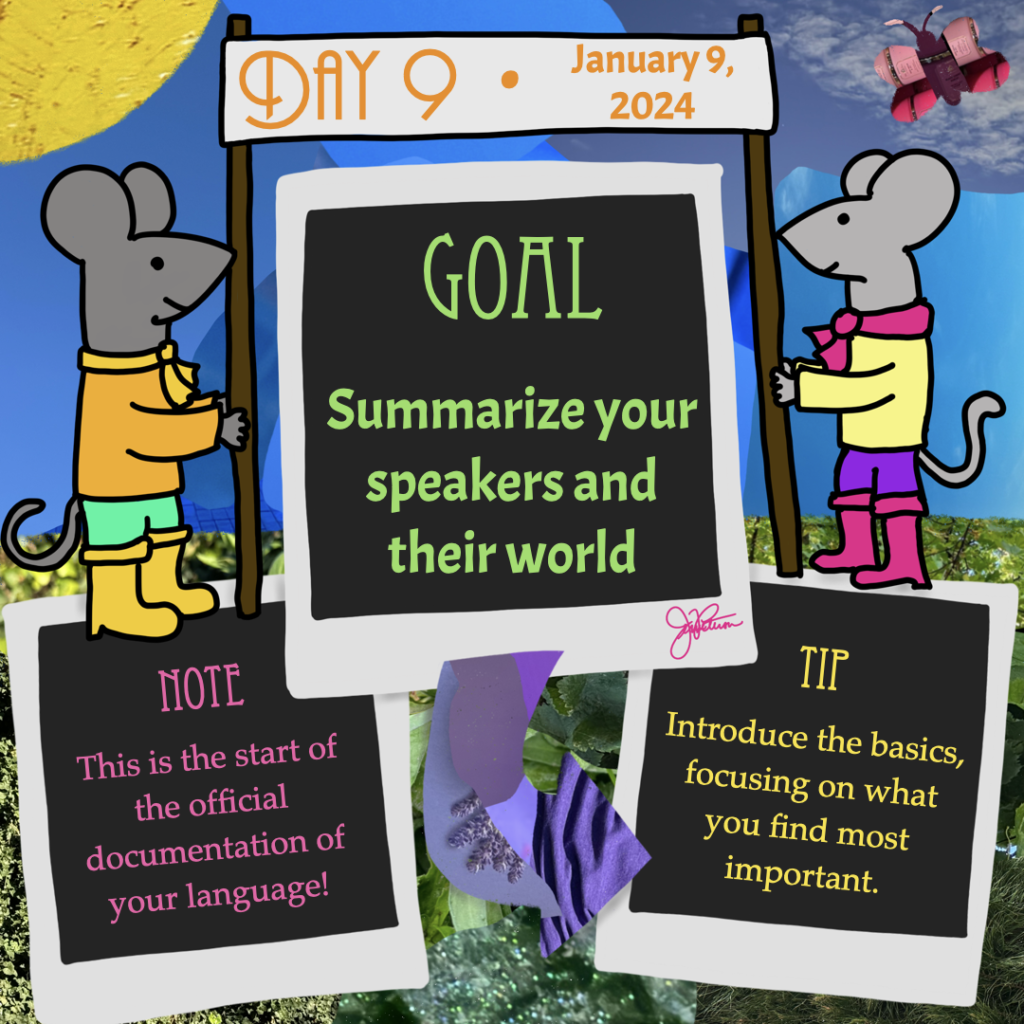
Goal: Summarize your speakers and their world
Note: This is the start of the official documentation of your language!
Tip: Introduce the basics, focusing on what you find most important.
Work focus: Solidify/Write/Share
You have brainstormed, created, listed, and designed features of your speakers and the world surrounding them. Today’s focus is taking all those notes and formalizing them into the start of an official document for your language. It is an introductory section that sets the scene to provide context for the language description that will follow.
You may have already created a document with a title page or title section that includes your intention for your conlang. If that’s the case, then you are ready to type in the first major section of that document. If you haven’t started a document yet, now is the time to begin.
The way you choose to document your language is really up to you and your preferences for keeping track of a large-scale project. However, some ways of documentation will make it easier to share with other people. If you want some tips for starting a more sharable, user-friendly kind of document, read on.
My first piece of advice is to keep a digital document. Whether you prefer Pages (like I do), Word, Google Docs, LaTeX, Scrivener, or whatever other word-processing and document-producing software you regularly use, a digital format means you can share the document. You need to be comfortable with the software/app if you want it to be more usable for yourself later on. My preference is to keep all language description information (which includes an introductory section on the speakers and world) in one document with clearly labeled sections. In this case, the introduction is the first section with a bolded “1” and bolded section heading. Using the textual style features of Pages allows me to assign that bit of text a special format that aids in producing a table of contents later on (and allows me to view the sections more easily in the sidebar to jump from section to section). Bolded, clearly titled sections allow for readers to more easily find information, too. The more you divide your work into digestible sections, the more readers can understand your vision for your language, and the more they can glean from reading what you’ve written.
If this language is intensely personal for you, and you have no plans of sharing it with a wider audience (other than people who may physically be near you), you may, of course, choose to document everything in a handwritten document. A few words of caution if you choose to do that are to remember that revising handwritten documents is much more difficult, and conlanging is a process of constant revision. To that end, I suggest you use a binder or ARC notebook system that allows for pages to be added, changed, or reordered more easily. Each page can then be assigned a topic—for every prompt this year that asks you to write or solidify information, you can have a page for that prompt. Then if you majorly revise information, you can focus on revising that page and changing it out for new information.
If you are creating an entirely alien world and speakers, you may want to have two introductory sections (one for the speakers and one for the conworld) with images incorporated to show what you mean. A picture goes a long way in helping people understand what you mean. If you’re less inclined to sketch these details (or to find images online to support your vision), then you can choose to describe everything in prose.
If you realize you have a LOT to say about the speakers and their world, you may want to limit how much time and/or written space you’ll devote to this introductory section in your document. Remember you can always have other supporting materials that are not included in your official language document. The goal for today’s prompt is to solidify the ideas you’ve been kicking around so you have the stage set, so to speak, for tomorrow and beyond. You may find out that you have so much to say about your conworld and conspeakers that you are essentially creating an entire fictional universe to house a much larger story. If that’s the case, you have a lot in common with J.R.R. Tolkien, and you should keep those notes for a writing project!
But please don’t attempt to write it all out today. You shouldn’t feel overwhelmed by responding to today’s prompt. Focus on the bits that are most important for understanding how you want to approach the language creation process and use as many images as you can to offer visual summaries so you can pack that information in without writing a novel in a day.
On the other hand, if you have already collected and written the information you have on your speakers, you may already be finished with today’s prompt before it even began. In that case, you might consider reviewing what you’ve written for any edits or revisions, you might add to what you’ve written by drawing images or maps to accompany the information, or you can use today to start preparing for tomorrow by researching (or reviewing) information on the International Phonetic Alphabet and the ways linguists refer to language sounds.
